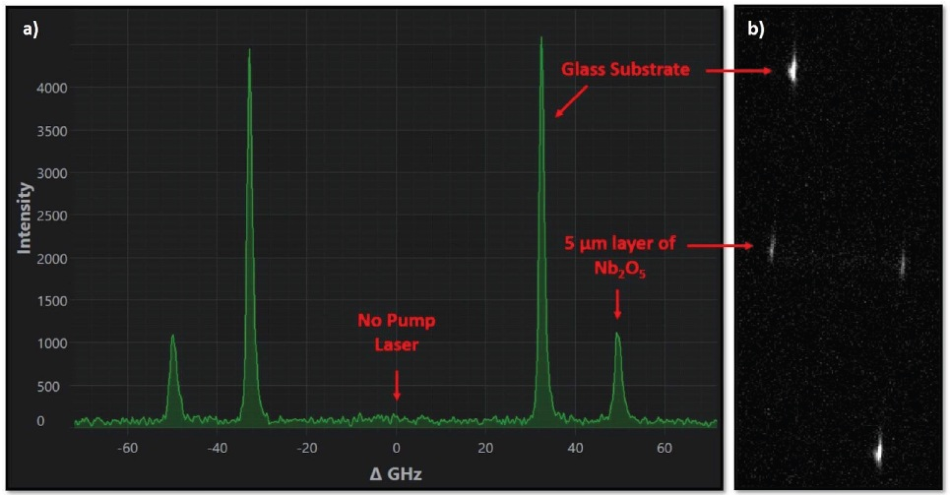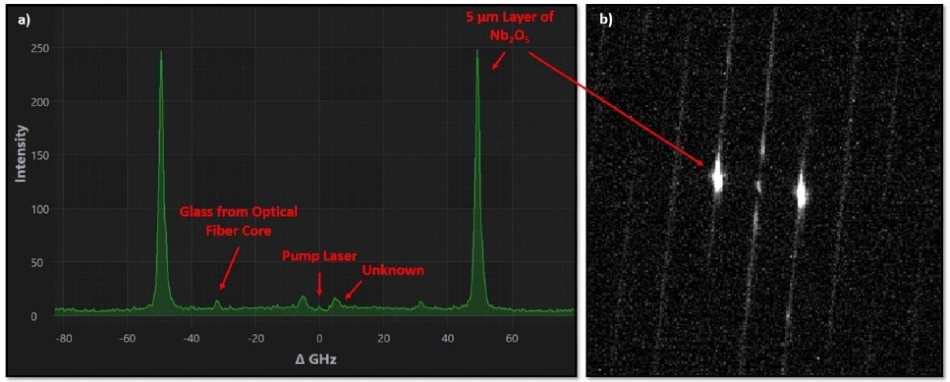A. Thin Film of Niobium Pentoxide on Glass or Germanium Substrate
Using a 20X microscope objective, the Brillouin frequency shift of a thin film of niobium pentoxide (Nb2O5) deposited on a glass or germanium substrate was measured. The film thickness in the two cases is 5 μm, which correlates to ~20 % of the collection/ excitation focal volume depth of the objective (~ 25 μm along the z-axis). The spectra in Figures 1 and 2 were gathered through utilizing 25 mW of laser power at the sample.
The measured frequency shift of Nb2O5 is 49.84 ± 0.05 GHz on glass substrate and 49.21 ± 0.03 GHz on germanium, indicating a difference of 0.63 GHz. This ΔGHz indicates the effect of substrate on the Brillouin frequency shifts of thin films. Additional work is needed to characterize and comprehend this possible effect. The substrate also seems to effect the Nb2O5 layer’s Brillouin signal intensity.
Intriguingly, its amplitude is around five times greater on germanium than on glass substrate. Exploratory research may, in the future, include testing the impact of substrate reflectivity on the Brillouin signal intensities of thin films. As the glass substrate is less reflective than the germanium substrate, a small pump laser signal can be seen in Figure 2. Also fascinating in Figure 2 is the presence of unidentified Brillouin peaks at low frequency shift (~ 4.9 GHz). Impurities related to the deposition method of Nb2O5 on germanium may account for the presence of these peaks. Further investigation is needed.

Figure 1. a) Brillouin frequency shift spectrum of a thin film of Nb2O5 deposited on a glass substrate. b) Raw sensor image. The time exposure was set to 20 seconds and the number of averages to 5. Image Credit: Lightmachinery

Figure 2. a) Brillouin frequency shift spectrum of a thin film of Nb2O5 deposited on a germanium substrate. b) Raw sensor image. The time exposure was set to 20 seconds and the number of averages to 5. Image Credit: Lightmachinery
Specifications
| Sample |
System |
- Thickness of Nb2O5: 5 μm
- Material: Nb2O5 layer on germanium substrate (not one crystal)
- The estimated Brillouin frequency shift for bulk Nb2O5 is about 47.3 GHz (using a speed of sound of 5311 m/s, a refractive index of 2.37, and a pump wavelength of 532 nm)
|
- Power at sample: 25 mW
- Pump wavelength: 532 nm
- FWHM of the instrument response: nominal 0.9 GHz
- Excitation/collection with 20X objective
- Repeatability of Brillouin shift: highly sample and exposure dependent; < 10 MHz is possible
|
B. Thin Film of Niobium Pentoxide on Germanium Substrate utilizing a lower noise detector
In order to obtain the germanium substrate’s Brillouin signal, an identical experience was carried out with a lower noise camera. Figure 3b) displays the raw sensor image, where the stronger peaks are ascribed to the Nb2O5 layer, while the fainter diagonal lines correlate with the germanium substrate’s Brillouin signal. This signal is hard to discern in the unwrapped spectrum due to the fact it is shaped as a weak uniform pedestal. The germanium has no clearly defined Brillouin peaks most likely because it is not single crystalline and also due to the strong absorption at that wavelength (532 nm). The presence of the unidentified peaks at ~ 4.9 GHz can also be noted, as discussed in section A).

Figure 3. a) Brillouin frequency shift spectrum of a thin film of Nb2O5 deposited on a germanium substrate, acquired with the lower noise camera. b) Raw sensor image. The time exposure was set to 10 seconds and the number of averages to 20. Image Credit: Lightmachinery
Specifications
| Sample |
System |
- Thickness of Nb2O5: 5 μm
- Material: Nb2O5 layer on germanium substrate (not one crystal)
- The approximate Brillouin frequency shift for bulk Nb2O5 is around 47.3 GHz (using a speed of sound of 5311 m/s, a refractive index of 2.37, and a pump wavelength of 532 nm).
|
- Power at sample: 25 mW
- Pump wavelength: 532 nm
- Camera: 0.7 e- rms read out noise sCMOS cooled to -5°C
- FWHM of the instrument response: nominal 0.9 GHz
- Excitation/collection with 20X objective
- Repeatability of Brillouin shift: highly sample and exposure dependent; < 10 MHz is possible
|

This information has been sourced, reviewed and adapted from materials provided by LightMachinery.
For more information on this source, please visit LightMachinery.